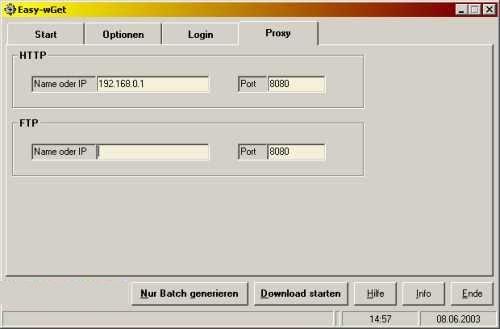

In Nov 2013 even March 2014, they were still showing wget 1.13.4 which was from 2011)įor the manpage, if you're checking from command line then it must be the version you're using so you can be fine there by just making sure your command is up to date / updating it.
#WGET WITH PROXY MANUAL#
Nov 2013 the gnu manual was very out of date. You can see the version at the top and check if it's the latest it shows dates too. Man pages at the command line are up to date, but the manual(a different entity from manpage), is not always an up to date wget version. Regarding the wget man page and the "wget manual". If set, the http_proxy and https_proxy variables should contain the urls of the proxies for http and https connections respectively. Way to specify proxy location, which Wget recognizes, is using the Wget supports proxies for both http and ftp retrievals. Use string as https proxy, instead of the one specified in environment. Use string as http proxy, instead of the one specified in environment. You see some things about http proxies listed there. In short, here's an example C:\sdf>wget -e http_proxy=127.0.0.1:8118 and another C:\sdf>set http_proxy=127.0.0.1:8118Ĭ:\sdf>wget The manual mentions wgetrc commands. For more detail you can check the online wget manual Or man wget (they are different things, it's often worth checking each) It will however respect the http_proxy environmental variable if it exists.Wget -help doesn't tell you much. The preferred method for configuring wget to use a proxy server is by using the wget specific configuration file. https_proxy = Īgain, if you need authentication, just add the necessary lines. If you do not have elevated (root or sudo) privileges, or want a user specific proxy setting, you can create a wgetrc file in your home directory at ~/.wgetrc and add the following lines. Set User Specific Proxy Settings for wgetĬhanging the /etc/wgetrc file will make the change global. Save the file and now wget will work on the command line through the proxy you just set. If your proxy requires authentication, add the following lines to your wgetrc file: http_proxy= You will need to uncomment (remove the leading pound sign) these lines and add the correct information like so: # You can set the default proxies for Wget to use for http, https, and ftp. # They will override the value in the environment.

# You can set the default proxies for Wget to use for http, https, and ftp. This was tested on Red Hat, CentOS, Fedora and Ubuntu. This file resides at /etc/wgetrc on most Linux systems. You can edit the wget configuration file to tell it what proxy server to use for http, https and ftp connections. This option is the preferred way if you only need wget to work with the proxy from the command line, or you need wget to use a different proxy from the one set in the environment with option 1.
#WGET WITH PROXY HOW TO#
How to Set the http_proxy Variable in Linux Configure wget To Work with your Proxy We cover this extensively in a past article, please refer to: By setting this variable, we can give wget the information it needs. The http_proxy variable tells other programs and shell commands where to look for a proxy server. Set the http_proxy Environmental VariableĮnvironmental variables are stored pieces of information that pass data to programs launched from a command shell. There are multiple ways to accomplish this. In this article we will discuss using the Linux wget command to respect our system proxy settings.


 0 kommentar(er)
0 kommentar(er)
